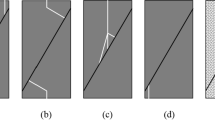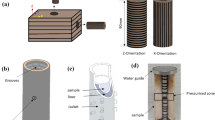Abstract
During hydraulic fracturing, thousands of barrels of fluid are injected into the rock surrounding the created fractures. Observations show that later during flowback, only a small fraction of the injected fluid volume is produced back. In tight naturally fractured formations, this can be explained by the leading role of preexisting rock discontinuities in the transport of fluids in such rocks. In this work, we investigate the mechanics of injected fluid flow in and out of preexisting rock discontinuities during a typical operational sequence of fracturing treatment, well shut-in and flowback. The mechanics of fluid flow in compliant discontinuities, where conductivity is sensitive to stress changes, is different from that in a stiff rock matrix. To understand and quantify rock pressurization, fluid leakoff and flowback rates, we develop a numerical model of fluid flow in a system of arbitrarily oriented discontinuities. Using this model, we predict spatial distribution of the injected fluid in a naturally fractured rock at any time after the beginning of the fracturing treatment as well as after the well shut-in and during flowback. The model explains the trapping of injected fluid in the discontinuities during production. We validate the model by comparison with field data and provide rough estimates of the volumetric fracturing fluid accumulation in the rock discontinuities after the treatment. The spatial extent of rock “flooding” around hydraulic fractures is found to depend on the density and orientation of rock discontinuities.


























Similar content being viewed by others
Abbreviations
- \(B_{\text{f}}\) :
-
Fluid compressibility (Pa−1)
- \(H_{\text{f}}\) :
-
Fracture height (m)
- \({\text{JRC}}\) :
-
Joint roughness coefficient (–)
- \(L_{\text{f}}\) :
-
Fracture half-length (m)
- \(L_{\text{front}}\) :
-
Depth of fluid penetration into discontinuity (m)
- \(L_{*}\) :
-
Length scale (m)
- \(N_{\text{d}}\) :
-
Number of discontinuities (–)
- \(T_{1}\) :
-
Fracture closure time (s)
- \(T_{2}\) :
-
Time where flowback begins (s)
- \(T_{*}\) :
-
Time scale (s)
- \(V\) :
-
Volume returning from discontinuities (m3)
- \(V_{{1{\text{d}}}}\) :
-
Volume returning from one discontinuity (m3)
- \(V_{\text{f}}\) :
-
Volume of fluid stored in a hydraulic fracture (m3)
- \(V_{{{\text{inj}}/{\text{HF}}}}\) :
-
Volume injected per fracture (m3)
- \(V_{{{\text{LO}}/{\text{HF}}}}\) :
-
Total leakoff volume per fracture (m3)
- \(V_{*}\) :
-
Volume scaling factor (m3)
- \(a\) :
-
Aperture of a discontinuity (mm)
- \(\tilde{a}\) :
-
Nondimensional aperture (–)
- \(a_{0}\) :
-
Zero-stress aperture of discontinuity (mm)
- \(a_{{0,{\text{s}}}}\) :
-
Shear-induced aperture of a discontinuity at zero effective stress (mm)
- \(a_{*}\) :
-
Aperture scale (mm)
- \(c\) :
-
Conductivity of a discontinuity (mD-ft)
- \(\tilde{c}\) :
-
Nondimensional conductivity (–)
- \(c_{*}\) :
-
Conductivity scale (mD-ft)
- \(g\) :
-
Gravity acceleration (m/s2)
- \(k\) :
-
Ratio of vertical stress to true vertical depth (MPa/m)
- \(k_{1}\) :
-
Minimum ratio of relative average horizontal stress to true vertical depth (MPa/m)
- \(k_{2}\) :
-
Maximum ratio of relative average horizontal stress to true vertical depth (MPa/m)
- \(l\) :
-
Length of intersection between a hydraulic fracture and discontinuity (m)
- \(l_{\text{front}}\) :
-
Nondimensional depth of fluid penetration into discontinuity (–)
- \(l_{\text{m}}\) :
-
Scale transformation factor from microns to the units of choice (meter) (–)
- \(p\) :
-
Fluid pressure (MPa)
- \(p_{\text{fb}}\) :
-
Flowback pressure (MPa)
- \(p_{\text{tr}}\) :
-
Treatment pressure (MPa)
- \(p_{*}\) :
-
Pressure scale (MPa)
- \(p_{\text{HF}}\) :
-
Fluid pressure in fracture (MPa)
- \(p_{\text{p}}\) :
-
Pore pressure (MPa)
- \(q\) :
-
Flow rate per unit length (m2/s)
- \(\tilde{q}\) :
-
Nondimensional flow rate per unit length (–)
- \(q_{*}\) :
-
Flow rate per unit length scale (m2/s)
- \(t\) :
-
Time (s)
- \(u_{\text{s}}\) :
-
Relative shear displacement of fracture wall faces (mm)
- \(v\) :
-
Volume of fluid stored in a discontinuity (m3)
- \(\tilde{v}\) :
-
Nondimensional volume of fluid stored in a discontinuity (–)
- \(\tilde{v}_{{1{\text{d}}}}\) :
-
Nondimensional volume returning from one discontinuity (–)
- \(v_{*}\) :
-
Volume scale (m3)
- \(w_{\text{f}}\) :
-
Fracture width (mm)
- \(x\) :
-
Coordinate along a discontinuity (m)
- \(z\) :
-
True vertical depth (m)
- \(\gamma_{\text{HF}}\) :
-
Nondimensional pressure in fracture (–)
- \(\gamma_{\text{fb}}\) :
-
Nondimensional flowback pressure (–)
- \(\gamma_{\text{tr}}\) :
-
Nondimensional treatment pressure (–)
- \(\Delta\) :
-
Spacing between two neighboring discontinuities (m)
- \(\vartheta\) :
-
Dip angle (–)
- \(\mu\) :
-
Fluid viscosity (cP)
- \(\tilde{\mu }\) :
-
Nondimensional fluid viscosity (–)
- \(\mu_{*}\) :
-
Fluid viscosity scale (cP)
- \(\xi\) :
-
Nondimensional coordinate (–)
- \(\varPi\) :
-
Nondimensional pressure (–)
- \(\rho\) :
-
Fluid density (kg/m3)
- \(\tilde{\rho }\) :
-
Nondimensional fluid density (–)
- \(\rho_{0}\) :
-
Fluid density at standard condition (kg/m3)
- \(\sigma_{\text{h}}\) :
-
Minimum horizontal stress (MPa)
- \(\sigma_{{{\text{h}}, {\text{av}}}}\) :
-
Average horizontal stress (MPa)
- \(\sigma_{{{\text{h}}, {\text{av}},0,{ \hbox{max} }}}\) :
-
Maximum average horizontal stress at zero depth (MPa)
- \(\sigma_{{{\text{h}}, {\text{av}},0,{ \hbox{min} }}}\) :
-
Minimum average horizontal stress at zero depth (MPa)
- \(\sigma_{\text{H}}\) :
-
Maximum horizontal stress (MPa)
- \(\sigma_{\text{n}}\) :
-
Normal stress applied to a discontinuity (MPa)
- \(\sigma_{\text{n}}^{{\prime }}\) :
-
Effective normal stress applied to a discontinuity (MPa)
- \(\sigma_{{{\text{n}},{\text{BP}}}}\) :
-
Normal stress applied to bedding planes (MPa)
- \(\sigma_{{{\text{n}},{\text{NF}}}}\) :
-
Normal stress applied to natural fractures (MPa)
- \(\sigma_{{{\text{n}}, {\text{ref}}}}^{'}\) :
-
Reference stress (MPa)
- \(\sigma_{\text{v}}\) :
-
Vertical stress (MPa)
- \(\tau\) :
-
Nondimensional time (–)
- \(\tau_{1}\) :
-
Fracture closure nondimensional time (–)
- \(\tau_{2}\) :
-
Nondimensional time where flowback begins (–)
- \(\phi_{\text{dil}}^{\text{eff}}\) :
-
Effective shear dilation angle (–)
- \(\varphi\) :
-
Azimuth angle (–)
- \(\varphi_{\text{p}}\) :
-
Proppant pack porosity (–)
References
Abbasi, M.A.: A Comparative Study of Flowback Rate and Pressure Transient Behaviour in Multifractured Horizontal Wells. ERA, Flinders Park (2013)
Alkouh, A., Mcketta, S., Wattenbarger, R.A.: Estimation of effective fracture volume using water flowback and production data for shale gas wells. SPE Hydraul. Fract. Technol. Conf. (2013). https://doi.org/10.2118/166279-MS
Anderson, E.M.: The dynamics of faulting and dyke formation with applications to Britain. Book (1951). https://doi.org/10.3109/07434618.2013.815801
Barton, N., Bandis, S., Bakhtar, K.: Strength, deformation and conductivity coupling of rock joints. Int. J. Rock Mech. Min. Sci. 22(3), 121–140 (1985). https://doi.org/10.1016/0148-9062(85)93227-9
Barton, N., Choubey, V.: The shear strength of rock joints in theory and practice. In: Rock Mechanics, vol. 10 (1977)
Batzle, M., Wang, Z.: Seismic properties of pore fluids. Geophysics 57(11), 1396–1408 (1992). https://doi.org/10.1190/1.1443207
Brown, E.T., Hoek, E.: Trends in relationships between measured in situ stresses and depth. Int. J. Rock Mech. Min. Sci. (1978). https://doi.org/10.1016/0148-9062(78)91227-5
Carslaw, H.S., Jaeger, J.C.: Conduction of Heat in Solids. Clarendon Press, Oxford (1986)
Chen, Z., Narayan, S.P., Yang, Z., Rahman, S.S.: An experimental investigation of hydraulic behaviour of fractures and joints in granitic rock. Int. J. Rock Mech. Min. Sci. 37(7), 1061–1071 (2000). https://doi.org/10.1016/S1365-1609(00)00039-3
Clarkson, C.R., Williams-Kovacs, J.: Modeling two-phase flowback of multifractured horizontal wells completed in shale. SPE J. 18(04), 795–812 (2013). https://doi.org/10.2118/162593-PA
Durham, W.B., Bonner, B.P.: Self-propping and fluid flow in slightly offset joints at high effective pressures. J. Geophys. Res. (1994). https://doi.org/10.1029/94JB00242
Economides, M.J., Nolte, K.G.: Reservoir Stimulation. Wiley, Hoboken (2000)
Fredd, C.N., McConnell, S.B., Boney, C.L., England, K.W.: Experimental study of fracture conductivity for water-fracturing and conventional fracturing applications. SPE J. 6(03), 288–298 (2001). https://doi.org/10.2118/74138-PA
Gale, J.F.W., Laubach, S.E., Olson, J.E., Eichhubl, P., Fall, A.: Natural fractures in shale: a review and new observations. AAPG Bull. 98(11), 2165–2216 (2014). https://doi.org/10.1306/08121413151
Godefroy, S.N., Zuo, J.Y., Fujisawa, G., Keefe, M.D., Ardila, M., Canas, J.A., De Santo, I., Cig, K.: Discussion on Formation Fluid Density Measurements and Their Applications (2008). https://doi.org/10.2118/114648-ms
Griffith, C., McClure, M.: Insights from pressure transients at observation wells near hydraulically fractured wells in a domestic shale play. Interpretation 4(4), T567–T576 (2016). https://doi.org/10.1190/INT-2015-0182.1
Houzé, O., Viturat, D., Fjaere, O., Trin, S.: Dynamic data analysis. In: Kappa Engineering (2017)
Jaeger, J.C., Cook, N.G.W., Zimmerman, R.W.: Fundamentals of rock mechanics fourth edition. In: Rock mechanics (2007). https://doi.org/10.1111/jocn.12732
Kappa company website: https://www.kappaeng.com/
Kondash, A.J., Albright, E., Vengosh, A.: Quantity of flowback and produced waters from unconventional oil and gas exploration. Sci. Total Environ. 574, 314–321 (2017). https://doi.org/10.1016/j.scitotenv.2016.09.069
Llanos, E.M., Jeffrey, R.G., Hillis, R., Zhang, X.: Hydraulic fracture propagation through an orthogonal discontinuity: a laboratory, analytical and numerical study. Rock Mech. Rock Eng. 50(8), 2101–2118 (2017). https://doi.org/10.1007/s00603-017-1213-3
Singh, K.K., Singh, D.N., Gamage, R.P.: Effect of sample size on the fluid flow through a single fractured granitoid. J. Rock Mech. Geotech. Eng. (2016). https://doi.org/10.1016/j.jrmge.2015.12.004
Stanchits, S., Desroches, J., Burghardt, J., Surdi, A., Whitney, N.: Rock fabric influence on hydraulic fracture propagation. In: 77th EAGE Conference and Exhibition (2015). https://doi.org/10.3997/2214-4609.201412632
Suarez-Rivera, R., Burghardt, J., Stanchits, S., Edelman, E., Surdi, A.: Understanding the effect of rock fabric on fracture complexity for improving completion design and well performance. Int. Pet. Technol. Conf. (2013). https://doi.org/10.2523/17018-MS
Valko, P., Economides, M.J.: Hydraulic Fracture Mechanics. Wiley, Chichester (1995)
Walsh, J.B.: Effect of pore pressure and confining pressure on fracture permeability. Int. J. Rock Mech. Min. Sci. (1981). https://doi.org/10.1016/0148-9062(81)90006-1
Walton, I., McLennan, J.: The role of natural fractures in shale gas production. In: Effective and Sustainable Hydraulic Fracturing (2013). https://doi.org/10.5772/56404
Wang, J., Elsworth, D.: Hydraulic fracturing with leakoff in a dual porosity medium. ARMA (2017). https://doi.org/10.1016/j.ijrmms.2018.04.042
Weng, X., Kresse, O., Chuprakov, D., Cohen, C.E., Prioul, R., Utpal Ganguly, S., Ganguly, U.: Applying complex fracture model and integrated workflow in unconventional reservoirs. J. Pet. Sci. Eng. (2014). https://doi.org/10.1016/j.petrol.2014.09.021
Williams-Kovacs, J.D., Clarkson, C.R., Zanganeh, B.: Case studies in quantitative flowback analysis. SPE (2015). https://doi.org/10.2118/175983-MS
Willis-Richards, J., Watanabe, K., Takahashi, H.: Progress toward a stochastic rock mechanics model of engineered geothermal systems. J. Geophys. Res.: Solid Earth 101(B8), 17481–17496 (1996). https://doi.org/10.1029/96JB00882
Zhang, J.: Pore pressure prediction from well logs: methods, modifications, and new approaches. Earth Sci. Rev. (2011). https://doi.org/10.1016/j.earscirev.2011.06.001
Zhou, J.Q., Hu, S.H., Fang, S., Chen, Y.F., Zhou, C.B.: Nonlinear flow behavior at low Reynolds numbers through rough-walled fractures subjected to normal compressive loading. Int. J. Rock Mech. Min. Sci. 80, 202–218 (2015). https://doi.org/10.1016/j.ijrmms.2015.09.027
Acknowledgements
The authors wish to thank Dr. Dean Willberg for the idea of this study, Dr. Maxim Chertov, Dr. Xiaowei Weng, and Dr. Pavel Spesivtsev for deep technical review of this work. We are also thankful to Dr. Konstantin Sinkov, Dr. Denis Syresin and Dr. Boris Krasnopolsky for constructive discussions; Dr. Sergey Stanchits, Dr. Ella Maria Llanos, Dr. Julia Gale, and Dr. Nick Barton for permission to use their materials in this paper. We appreciate Schlumberger company for permission to publish this work.
Author information
Authors and Affiliations
Corresponding author
Additional information
Publisher's Note
Springer Nature remains neutral with regard to jurisdictional claims in published maps and institutional affiliations.
Rights and permissions
About this article
Cite this article
Ipatova, A., Chuprakov, D. Role of Preexisting Rock Discontinuities in Fracturing Fluid Leakoff and Flowback. Transp Porous Med 135, 137–180 (2020). https://doi.org/10.1007/s11242-020-01472-3
Received:
Accepted:
Published:
Issue Date:
DOI: https://doi.org/10.1007/s11242-020-01472-3




